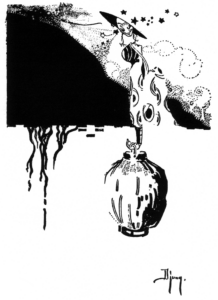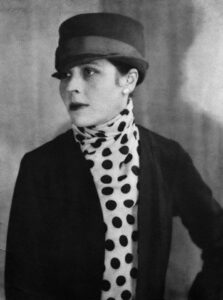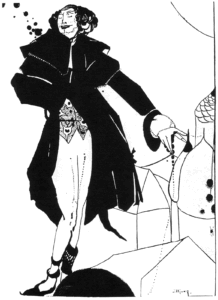HEADNOTE
Often referred to as ‘the most famous unknown of the century’, Djuna Barnes was among those expat writers of high modernist literature alongside Gertrude Stein, Ernest Hemingway, and H.D. (Hilda Doolittle) whose contributions characterized the genre and its period as decadent, sensual, and lost. A closer look at Djuna Barnes’ writing career shows that before she joined the expatriate community of writers in 1920s Paris, her earlier works from the 1910s were already experimenting with some of the themes that she would explore more fully in famous works such as Nightwood (1936). Those themes included: sexuality, gender identity, societal deviation, and women’s rights. In her poem ‘Suicide’, published in 1915, more than two decades before Nightwood, we see Barnes critical of the world around her, a world that does not favor those who fall outside of the ‘norm’. This is a world that often ostracizes those who society would deem troublesome: people with disabilities, members of the LGBTQ community, women who deviated from societal expectations, or simply dissenting parties who were disillusioned with society. Literary historian Mary I. Unger argues that during this time the counterculture of urban New York City, in which Djuna found herself, was thought of as a ‘wasteland teeming with the disorderly, disabled, and unsightly’ (128). Barnes felt at home amongst the misfits of society, for she herself always was one, and ‘Suicide’ reflects precisely what misfits experienced in a world that aimed to exclude them.
Barnes’ poem ‘Suicide’ highlights the haunting imagery of ‘shattered’ and ‘bruised’ bodies: the corpses of two women who committed suicide. Their bodies are described as mangled and beaten down by a society that failed them. The women in question who society deemed unfavorable for her perceived failure to perform a more ‘feminine’ or ‘proper’ gender persona appear to meet their tragic fates because of this deviation from patriarchal expectations. The corpses of the two bodies are described in such a way as to convey how they were mistreated, excluded, and forgotten women not only in life but also in death. Irene Martyniuk describes the women in the poem as ‘defeated’ by the forces of ‘society’s conventions’ (63). Readers of the poem would do well to view Barnes’ descriptions of the women’s dead bodies as not only showcasing the harsh realities of the impending death and carnage that already existed and would continue in the wake of World War I but also as a voice who represents the members of the Lost Generation who were ‘lost’ because they were excluded. Although Barnes wrote ‘Suicide’ while living in New York, her transatlantic thinking is nevertheless reflected in the poem as she works to connect the trauma of war with the trauma of social marginalization, for both result in death whether physical or spiritual. In fact, Barnes’ identity as a lesbian and her own experience of social marginalization may well be the reason that she self-exiled to Paris alongside Gertrude Stein and H.D.: She may have been in search of community acceptance, or at least escaping persecution.
A visual artist as well as a poet, Barnes created striking drawings for a range of publications, including a chapbook which included this poem, The Book of Repulsive Women: 8 Rhythms and 5 Drawings. As Quin Gilbert-Forlini points out, Barnes did not originally link the five drawings in the chapbook with specific poems, but instead clustered them together at the end. Subsequent editors have sometimes attempted to match up the illustrations with specific poems from the collection, though Gilbert-Forlini judges those attempts unsuccessful given the artist’s original organization for the poetry printed along with her art. Barnes famously hated The Book of Repulsive Women and actively worked to repress its publication in the decades following its initial release. While we can only speculate as to why the creator hated her own creation, Gilbert-Forlini convincingly argues that readers of the 1920s refused to acknowledge Barnes’ sexuality, nor would readers acknowledge Barnes’ insistence that lesbianism is the subject of the book. It is our responsibility, then, as contemporary readers to recognize that the corpse(s) of the poem represent the bodies of women who identified as marginalized members of society, that they were likely lesbians, and that they committed suicide because of society’s refusal to accept them.
Editorial work on this entry by Genesis Roblero

Djuna Barnes illustration from The Book of Repulsive Women.
Suicide (1915)

Author Djuna Barnes circa 1921.
Corpse A
They brought her in, a shattered small Cocoon,
With a little bruised body1This description of a woman’s bruised corpse not only signifies the physical injuries from suicide but also the emotional injuries the woman suffered long before she ended her own life. Barnes could be alluding to two suicides: the physical suicide that the woman inflicts on herself as a result of social suicide (or death) society inflicts through the act of marginalization and exclusion. The moment that she deviated from society’s plans for her, she was marked for death. like a startled moon;
And all the subtle symphonies of her a twilight rune.2The phrase “subtle symphonies” refers to how the woman still had a story to tell. Because she was silenced by society throughout her life, her corpse contains all the runes (meaning, a poem or song) that will remain unsaid or unwritten. This adds to the tragedy of her death and leaves readers not only pondering what was lost in death but also how her death might have been prevented were she not silenced.
Corpse B
They gave her hurried shoves this way and that.
Her body shock-abbreviated as a city cat.3This simile might represent the dehumanization she suffered from a society that likens women to animals, in this case, a street cat of New York. Street cats can be found scavenging for food and shelter, often lacking a sense of belonging or community aside from other stray animals who are just trying to survive. Like the cat, this woman struggles to survive on the outskirts of society amongst other persons who society as marked as deviant and undesirable.
She lays out listlessly like some small mug of beer gone flat.4Another simile that highlights how tragically the woman was ostracized during her life. When her corpse is found, she is nothing more than a “flat,” strewn-out body as spiritless as a “flat” or stale mug of beer.
Djuna Barnes.

“After All, One Must Be Faithful to One’s Bracelets.” Art by Djuna Barnes.
Source Text:
Barnes, Djuna. ‘Suicide’. Bruno’s Weekly. Edited by Guido Bruno in His Garret on Washington Square 11.20 (May 13, 1915), 702.
References:
Barnes, Djuna. The Book of Repulsive Women: 8 Rhythms and 5 Drawings. New York: Guido Bruno, 1915.
Fox, Meghan C. “‘Vivid and Repulsive as the Truth’: Hybridity and Sexual Difference in Djuna Barnes’s The Book of Repulsive Women.” The Space Between: Literature and Culture 1914-1945 12.3/6 (2016). https://scalar.usc.edu/works/the-space-between-literature-and-culture-1914-1945/vol12_2016_fox
Gilman-Forlini, Quinn. “‘An Analysis of Djuna Barnes’ Detestation for ‘The Book of Repulsive Women.’” Apollon: Humanities Institute, 5 September 2014. https://www.apollonejournal.org/apollon-journal/erasing-the-grotesque
Martyniuk, Irene. “Troubling the ‘Master’s Voice’: Djuna Barnes’s Pictorial Strategies,” Mosaic: An Interdisciplinary Critical Journal, vol. 31, no. 3, University of Manitoba, 1998, 61–81.
Unger I, Mary, “‘Dropping Crooked into Rhyme’: Djuna Barnes’s Disabled Poetics in ‘The Book of Repulsive Women,’” Legacy, vol. 30, no. 1, University of Nebraska Press, 2013, 124–50.
Image Citations:
“After All, One Must Be Faithful to One’s Bracelets.” Art by Djuna Barnes. Courtesy of Wikimedia Commons. https://commons.wikimedia.org/wiki/File:Djuna_Barnes_-_Villager.gif
Djuna Barnes. Courtesy of Wikimedia Commons.
https://commons.wikimedia.org/wiki/File:Djunabarnes.jpg
Djuna Barnes. Book of Repulsive Women [one of five illustrations] Courtesy of Wikimedia Commons. https://commons.wikimedia.org/wiki/File:Djuna_Barnes_-_Book_of_Repulsive_Women.png